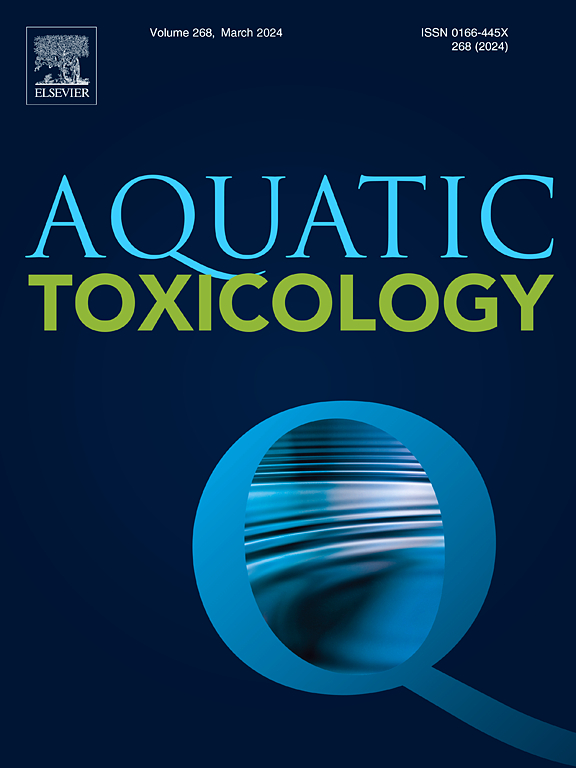Impact of diethyl phthalate on freshwater planarian behaviour, regeneration, and antioxidant defence
IF 4.1
2区 环境科学与生态学
Q1 MARINE & FRESHWATER BIOLOGY
引用次数: 0
Abstract
Diethyl phthalate (DEP) has been widely used as a plasticiser in various consumer products, including cosmetics, personal care items, and pharmaceuticals, and recent studies reported a higher abundance of this priority phthalate in the aquatic environment. DEP is a potential endocrine disruptor, affecting immune systems in humans and wildlife even at low-level chronic exposure. As concern over phthalates increases globally, regulatory bodies focus more on their environmental impact. However, limited research is available, particularly using model organisms like planarians. Planarians are ideal for toxicological studies and may provide insightful information on pollutants' neurotoxic, developmental, and ecological effects, especially in freshwater environments where planarians play a vital role in ecosystem balance. Therefore, the objective of the current study was to examine the toxicity of DEP using the freshwater Dugesia sp., as an experimental animal. The LC50 for the test organism was calculated using DEP concentrations of 800, 400, 200, 100, and 50 µM, with an estimated LC50 of 357.24 µM. Furthermore, planarians were exposed to sub-lethal DEP concentration (178.62 µM) for one day as well as eight days to evaluate the impact of DEP on planarian locomotion, feeding behaviour, and regeneration ability. At sub-lethal concentration, locomotion and feeding ability were decreased, and regeneration was delayed. Furthermore, neuro-transmittance in planaria was altered by sub-lethal DEP concentration, as indicated by a reduced acetylcholinesterase (AChE) activity. DEP exposure induced oxidative damage in the tested planarians as shown by a marked increase in stress biomarkers, including lipid peroxidation levels and antioxidant enzymes such as superoxide dismutase (SOD), catalase (CAT), peroxidase (POX), and glutathione S-transferase (GST). Our study revealed that DEP exposure may prove fatal to freshwater organisms, such as planarians. The observed alterations in behaviour and regeneration ability demonstrate the severity of the effects exerted by DEP as a toxicant in aquatic ecosystems, thereby indicating the need to restrict its usage to protect aquatic environments.
邻苯二甲酸二乙酯对淡水浮游动物行为、再生和抗氧化防御的影响。
邻苯二甲酸二乙酯(DEP)被广泛用作各种消费品(包括化妆品、个人护理用品和药品)的增塑剂,最近的研究报告显示,这种优先邻苯二甲酸酯在水生环境中的含量较高。DEP 是一种潜在的内分泌干扰物,即使长期低量接触也会影响人类和野生动物的免疫系统。随着全球对邻苯二甲酸盐的关注度不断提高,监管机构更加关注其对环境的影响。然而,目前的研究还很有限,尤其是利用模式生物(如浮游动物)进行的研究。浮游动物是理想的毒理学研究对象,可为污染物的神经毒性、发育和生态效应提供有价值的信息,尤其是在淡水环境中,浮游动物在生态系统平衡中扮演着重要角色。因此,本研究的目的是以淡水 Dugesia sp.为实验动物,研究 DEP 的毒性。使用浓度为 800、400、200、100 和 50 µM 的 DEP 计算了测试生物的半数致死浓度,估计半数致死浓度为 357.24 µM。此外,还将刨腹鱼暴露在亚致死浓度(178.62 µM)下一天和八天,以评估 DEP 对刨腹鱼运动、摄食行为和再生能力的影响。在亚致死浓度下,运动和摄食能力下降,再生能力延迟。此外,亚致死浓度的 DEP 会改变刨花的神经传导,乙酰胆碱酯酶(AChE)活性降低就表明了这一点。暴露于 DEP 会诱发受测刨腹鱼的氧化损伤,这表现在应激生物标志物的显著增加,包括脂质过氧化水平和抗氧化酶,如超氧化物歧化酶(SOD)、过氧化氢酶(CAT)、过氧化物酶(POX)和谷胱甘肽 S 转移酶(GST)。我们的研究表明,接触 DEP 可能会对淡水生物(如浮游动物)造成致命伤害。观察到的行为和再生能力的改变表明,作为一种有毒物质,DEP 对水生生态系统的影响非常严重,因此有必要限制其使用,以保护水生环境。
本文章由计算机程序翻译,如有差异,请以英文原文为准。
求助全文
约1分钟内获得全文
求助全文
来源期刊

Aquatic Toxicology
环境科学-毒理学
CiteScore
7.10
自引率
4.40%
发文量
250
审稿时长
56 days
期刊介绍:
Aquatic Toxicology publishes significant contributions that increase the understanding of the impact of harmful substances (including natural and synthetic chemicals) on aquatic organisms and ecosystems.
Aquatic Toxicology considers both laboratory and field studies with a focus on marine/ freshwater environments. We strive to attract high quality original scientific papers, critical reviews and expert opinion papers in the following areas: Effects of harmful substances on molecular, cellular, sub-organismal, organismal, population, community, and ecosystem level; Toxic Mechanisms; Genetic disturbances, transgenerational effects, behavioral and adaptive responses; Impacts of harmful substances on structure, function of and services provided by aquatic ecosystems; Mixture toxicity assessment; Statistical approaches to predict exposure to and hazards of contaminants
The journal also considers manuscripts in other areas, such as the development of innovative concepts, approaches, and methodologies, which promote the wider application of toxicological datasets to the protection of aquatic environments and inform ecological risk assessments and decision making by relevant authorities.
 求助内容:
求助内容: 应助结果提醒方式:
应助结果提醒方式:


